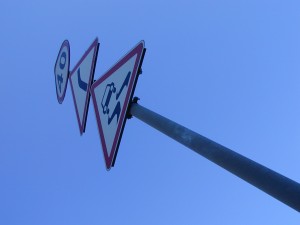 One of the benefits (and excitements) of learning to fly is that you have the ability to GO REALLY FAST. “There are no speed limit signs in the sky,” you might say.
One of the benefits (and excitements) of learning to fly is that you have the ability to GO REALLY FAST. “There are no speed limit signs in the sky,” you might say.
You’re absolutely right that there are no speed limit signs in the sky. But that doesn’t mean that there are no aircraft speed limits. Because, in fact, there are.
The main thing to remember is that, in general, “if you go high, you can fly!” – Above 10,000 feet MSL (mean sea level – this means “above sea level”) there are no aircraft speed limits. You can fly as fast as your little heart (and the planes little – or not so little – motor) desires.
But below 10,000′ MSL, you have to maintain an indicated airspeed at or below 250 knots (KIAS). And that’s not all.
If an airplane is within class B airspace, regardless of altitude, it is limited to 250 knots indicated airspeed. If it is flying “under the shelf” of class B airspace, it is limited to 200 knots indicated airspeed. There are also areas called “class B corridors” where aircraft can fly without clearance into class B airspace, and in these corridors, they are limited to 200 knots indicated airspeed as well.
Regulations also state that at or below 2500 AGL (above ground level – over the ground), when within 4 nautical miles from a class C or class D airport, you cannot fly any faster than 200 knots indicated airspeed. Air Traffic Control (ATC) may ask an aircraft to deviate from the 200 KIAS limit, but cannot ask an aircraft to go faster than the 250 KIAS limit (though they can always ask you to go slower).
Generally, these rules are in place so that aircraft with wildly different performance aren’t flying at all different speeds when they are likely to be near one another. Additionally, the lower you go, the more likely you are to be flying with birds, and if you are flying more slowly, if you happen to hit a bird (known as a bird strike), you are less likely to do significant damage to your airplane, such that you would not be able to control and land it.
For those of you who want to see the actual regulation, see 14 CFR 91.117. The above information applies to aircraft speed limits in the United States, under Federal Aviation Administration (FAA) regulations. Other countries may have different rules.
Have any more questions or comments about aircraft speed limits? Hurry up and tell us below!
Andrew Hartley is a Certificated Flight Instructor in Columbus, Ohio.
Nice job with this article. Thank you for posting.
Thanks, VaHelicopter, for reading!
Good article, thanks!
One quick thing, there actually isn’t a speed limit inside class B airspace. Most class B airspace falls into the “250 kts below 10,000 ft” rule, but in situations such as Atlanta where the Bravo goes up to 12,500, as soon as you clear 10,000 ft you no longer have speed restrictions regardless if you are in the Bravo or not.
Thanks for the article!
Sam: Thanks for the clarification! I hadn’t really thought about that, but it makes sense.
You certainly do need clearance to fly into bravo, corridor or not. The FARs provide no exception for a transition corridor.
FAR 91.131 “Operations in Class B airspace”
(a) Operating rules. No person may operate an aircraft within a Class B airspace area except in compliance with §91.129 and the following rules:
(1) The operator must receive an ATC clearance from the ATC facility having jurisdiction for that area before operating an aircraft in that area.
Actually, a corridor through class B airspace is not part of the class B airspace. It was carved out to allow the passage of “uncontrolled” traffic, so class B rules and regulations do not apply. No exception is needed in 91.131 because it is not class B airspace.
Geoff: Thanks for the comment! As Tommy says, the “corridor” is actaully carved out of Class B, and I believe it is considered Class E airspace. That said, It probably wouldn’t hurt to be listening and/or talking to the Class B control authority, but again, in the corridor, I believe there is usually a specific frequency to be stating your intentions and location, similar to what is expected when you are flying at a non-towered airport.
I have not personally flown in a Class B corridor, but this is the way I understand it.
Remember also that above 10,000′ MSL, the speed limit is Mach 0.99 (cannot exceed the speed of sound).
That is true, Zacc, and if you are lucky enough to be flying an aircraft where you have to worry about that, you are a luckier man than I. :)
Read you info about speed limits in class C and D airspace, thanks.
However, you might review the Class B speed limit info. There is speed limit below 10,000 feet, 250 kts, but no other speed limit in Class B. So in Atlanta, when you clear 10,oo0′ in the climb, you may go above 250 kts.
You’re right, Hugo, and thanks. This is all laid out in 14 CFR Part 91.117 – which also says underneath the floor of a shelf of class B, or in a class B corridor, in which case the speed limit is limited to 200 knots.